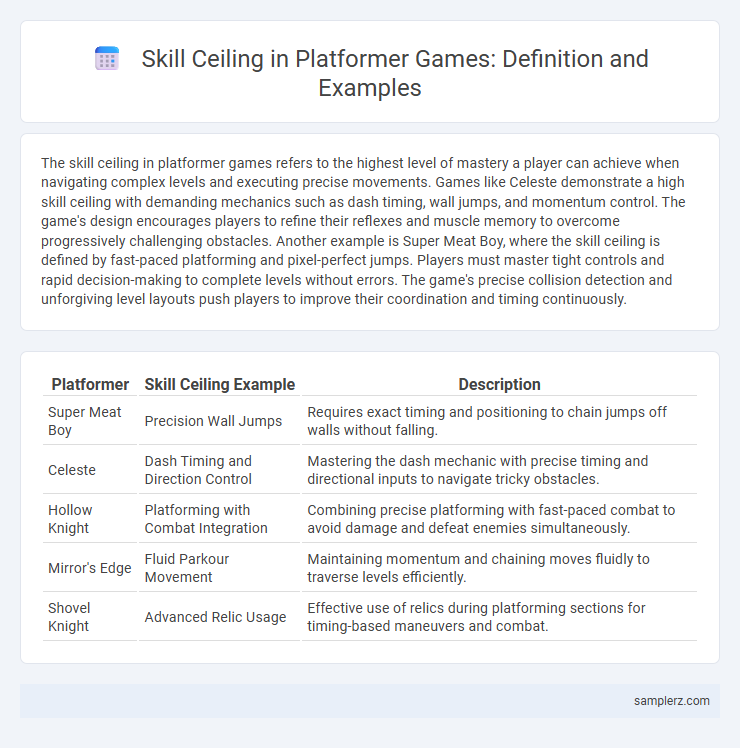The skill ceiling in platformer games refers to the highest level of mastery a player can achieve when navigating complex levels and executing precise movements. Games like Celeste demonstrate a high skill ceiling with demanding mechanics such as dash timing, wall jumps, and momentum control. The game's design encourages players to refine their reflexes and muscle memory to overcome progressively challenging obstacles. Another example is Super Meat Boy, where the skill ceiling is defined by fast-paced platforming and pixel-perfect jumps. Players must master tight controls and rapid decision-making to complete levels without errors. The game's precise collision detection and unforgiving level layouts push players to improve their coordination and timing continuously.
Table of Comparison
| Platformer | Skill Ceiling Example | Description |
|---|---|---|
| Super Meat Boy | Precision Wall Jumps | Requires exact timing and positioning to chain jumps off walls without falling. |
| Celeste | Dash Timing and Direction Control | Mastering the dash mechanic with precise timing and directional inputs to navigate tricky obstacles. |
| Hollow Knight | Platforming with Combat Integration | Combining precise platforming with fast-paced combat to avoid damage and defeat enemies simultaneously. |
| Mirror's Edge | Fluid Parkour Movement | Maintaining momentum and chaining moves fluidly to traverse levels efficiently. |
| Shovel Knight | Advanced Relic Usage | Effective use of relics during platforming sections for timing-based maneuvers and combat. |
Defining Skill Ceiling in Platformer Games
The skill ceiling in platformer games refers to the maximum level of expertise and mastery that players can achieve through precise control, advanced techniques, and deep understanding of game mechanics. Titles like Celeste illustrate a high skill ceiling by requiring players to execute complex maneuvers such as perfect dashes, precise wall jumps, and frame-perfect inputs. This challenging design encourages continuous improvement, rewarding players who invest time in mastering movement patterns and exploiting the game's physics engine.
Precision Jumping: Testing Player Mastery
Precision jumping in platformer games exemplifies a high skill ceiling where players must time their jumps with exact accuracy to navigate challenging obstacles. Mastery demands impeccable control over character movement and split-second decision-making, often requiring frame-perfect inputs. Titles like Celeste showcase this mechanic, pushing player expertise through intricate level design that rewards precision and consistency.
Advanced Movement Techniques and Combos
Advanced movement techniques such as wall jumps, dash cancels, and air drifts significantly raise the skill ceiling in platformers by requiring precise timing and muscle memory. Mastery of intricate combos involving rapid chaining of attacks and movement maneuvers further differentiates novice players from experts. Games like Celeste and Super Meat Boy exemplify how complex skill ceilings encourage continuous player improvement through challenging mechanics.
Level Design that Elevates Skill Potential
The skill ceiling in platformers is often defined by the complexity and creativity of level design, which challenges players to master precise timing, intricate movement, and advanced techniques. Levels with varied terrain, hidden paths, and dynamic obstacles encourage continuous player improvement and strategic exploration. Titles like Celeste and Super Meat Boy exemplify how thoughtful level design elevates skill potential by balancing accessibility with demanding challenges.
Speedrunning: Pushing Platformer Limits
Speedrunning in platformers showcases a high skill ceiling through precise frame-perfect jumps, optimized route selection, and exploiting game mechanics like wall jumps and crouch slides to minimize run time. Games like Super Meat Boy and Celeste exemplify this by requiring players to master difficult sequences repeatedly to shave off milliseconds. The competitive nature of speedrunning drives innovation in movement techniques, elevating player skill beyond casual platforming.
Adaptive Enemy Patterns and Challenges
Platformer games often feature adaptive enemy patterns that increase the skill ceiling by requiring players to anticipate and react to evolving attack behaviors. Games like Hollow Knight demonstrate this with enemies that change tactics based on player actions, demanding precise timing and strategic decision-making. This dynamic challenge system pushes players to continuously refine their skills, enhancing replayability and mastery.
Player-Driven Shortcuts and Exploits
Player-driven shortcuts in platformer games, such as speedrunning maneuvers in "Celeste," showcase high skill ceilings by requiring precise input timing and deep game knowledge. Exploits like wall clipping or sequence breaking in "Super Mario World" allow players to bypass intended level design, demanding mastery of game physics and mechanics. These techniques elevate competitive play and speedrunning communities by rewarding creativity and technical skill.
Environmental Hazards Requiring High Skill
Environmental hazards like precision-timed spike traps and moving platforms in platformers demand exceptional hand-eye coordination and split-second decision-making skills. Navigating through these requires mastering perfect jump timing and trajectory control to avoid instant failure. Games like "Celeste" exemplify skill ceilings by challenging players with complex hazard patterns that test their reflexes and environmental awareness.
Mastering Timing and Reflexes
Mastering timing and reflexes in platformers like Celeste demands precise input execution within narrow windows, showcasing a high skill ceiling. Players develop muscle memory to flawlessly perform advanced techniques such as hyper-dashing and wall-jumping, pushing gameplay speed and accuracy to expert levels. This tight control over character movements highlights the complexity and depth of platformer skill mastery.
Community Benchmarks and High-Level Achievements
Speedrunning in platformers like Celeste showcases a high skill ceiling, with community benchmarks constantly pushing the limits through frame-perfect inputs and pixel-perfect precision. Elite players consistently achieve sub-30 minute full-game runs, demonstrating mastery of complex mechanics such as hyper-dashing and ultra-fast wall jumps. High-level achievements, tracked and verified on leaderboards, emphasize the dedication and skill required to compete at this elite tier of gameplay.

example of skill ceiling in platformer Infographic
 samplerz.com
samplerz.com